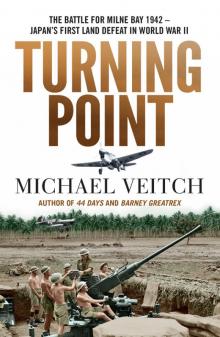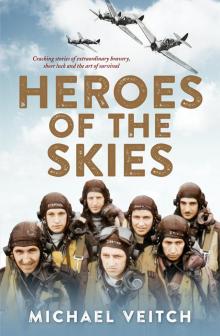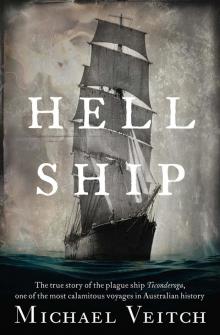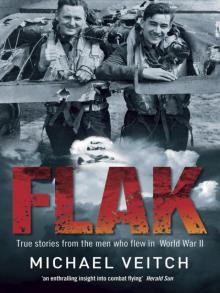- Home
- Michael Veitch
Turning Point Page 6
Turning Point Read online
Page 6
In Australia’s darkest hours in early 1942, when the Japanese onslaught to the north seemed unstoppable, three new fighter squadrons – 75, 76 and 77 – were formed with the panicked stroke of a governmental pen after a shipload of brand-new American P-40 Kittyhawk fighters, still in their crates, arrived unexpectedly into Botany Bay; they had been destined for the Dutch East Indies. Turnbull, who had already done more than enough to warrant him being allowed to sit out the remainder of the war in training, was instead asked to help instruct the young pilots who would man these new squadrons, and then lead them into battle against a hardened and apparently invincible enemy. He jumped at the chance.
In March 1942 he found himself at Port Moresby’s Twelve Mile Strip, a miserable, dusty patch of bush with neither facilities nor comforts, at least as bad as the worst desert airstrip he had encountered in Libya and beyond. It was also under constant attack by the Japanese from their closest base, an hour’s flying time away at Lae. Turnbull was one of the few pilots in this new squadron with battle experience, and the younger pilots held him in awe. As far as was possible, Turnbull would do his best to keep them alive, and teach them how to hit back at the enemy.
In this he was enormously assisted by his old 3 Squadron desert CO, now 75’s new commander, Squadron Leader John Jackson, a remarkable pilot and true leader of men, who, with Turnbull, helped forge the new charges into something like a cohesive fighting unit. In 75 Squadron’s six-week air defence of Port Moresby, the noses of the rapacious Japanese were bloodied for the first time in the war as this small band of Australian pilots fell upon the Zeros and Betty bombers like a pack of wild dogs – scrappy, fearless and determined. Between 21 March and 1 May 1942, 75 Squadron’s pilots accounted for over 30 Japanese aircraft destroyed and many more damaged, for a loss of twelve of their own. While this did not represent a significant blow against the Japanese in military terms, it was, as the squadron’s official history states, a ‘moral victory of incalculable value’, throwing into awry Japan’s timing for its invasion of New Guinea, and forcing its leaders to realise that their days of unchallenged conquest were over.
Such was the experience 75 Squadron was quickly gaining at Port Moresby that the new CO of the still-forming 76 Squadron, Squadron Leader Bernard ‘Barney’ Cresswell, was sent there on detachment to gain some combat hours for himself. A pilot of enormous flying – but no combat – experience, Cresswell and another Kittyhawk pilot were jumped by a detachment of Zeros during his first ever combat sortie over Lae on 17 April. Cresswell was unused to the split-second nature of air combat, and a moment’s hesitation cost him his life. His burning aircraft was observed to slam into the side of a mountain.
Turnbull, meanwhile, had added another three enemy aircraft to his tally, taking it to twelve, making him one of the RAAF’s highest-scoring pilots, and the ideal officer to step into Cresswell’s shoes as the men of 76 Squadron prepared for their turn in the limelight. Although torn to be leaving his comrades at Port Moresby, he suspected that he would soon be back there.
In May Turnbull was officially made 76 Squadron’s new commanding officer, and at Aitkenvale Weir airfield, near Townsville, he did his best to prepare another group of raw pilots for the heat of battle. At least he had been given more time than had 75 Squadron; he was even joined by a group of experienced pilots just returned from England. One was a true celebrity, Squadron Leader Keith ‘Bluey’ Truscott, who first made a name for himself on the sporting field with the Melbourne Football Club, and then became a Spitfire ace with 452 Squadron in England, destroying 16 German aircraft and earning himself the DFC and bar.
Truscott’s arrival home in May, however, had been bittersweet. He was exhausted, unfit and overweight, and suffering the emotional troughs of what would, in a much later age, be termed ‘post traumatic stress disorder’. The first most of the world knew of his return to Australia was his sudden appearance on the turf of the Richmond Oval in Melbourne, having quietly organised to play a game with his old club against their archrivals, the Richmond Tigers. When the crowd realised that it was indeed Truscott out there, back in his old jumper (retrieved from mothballs), they went wild with delight. The returning footballer, and now war hero, acknowledged the adoration of the fans on both sides and played the most atrocious game of his career. At one stage, the opposition slowed down play to give him a chance to kick a goal, but he was hopeless and he knew it, and every muscle in his body ached for days.
The press, starved of homegrown heroes, would not leave him alone. Eventually, he slipped out of the family home and checked himself into the Menzies Hotel under the name ‘Squadron Leader Williams’ and hid from the world. Then in July, he heard of the death of his great friend and fellow ace Paddy Finucane, who had to ditch his damaged Spitfire in the English Channel. To compound matters, the Air Board attempted to remove the rank awarded to Truscott in England and drop him back to Flight Lieutenant, an insult hurled at many pilots returning from operational flying in Europe at this time. Truscott fought the snub tooth and nail, and with the aid of friends in the press and a sympathetic public, managed to hold onto his two and a half stripes. Posted to the still-forming 76 Squadron, Truscott was now required to adapt to the heavy, solid Kittyhawk after the delicate ballerina of the Spitfire, and did not like it one bit. According to his biographer, Ivan Southall, it did what he asked of it, ‘but he couldn’t make it dance’.
A brilliant fighter pilot at altitude, Truscott was notoriously inept at low level, particularly when it came to judging the height of the ground. While attempting his first ever landing at No. 2 Operational Training Unit, in Mildura, he came in too slow, stalling just over the runway – at which point his Kittyhawk flipped upside down. With extraordinary skill, Truscott opened up his throttle and pointed the nose downwards, then, still inverted, managed to hold the aircraft off the ground, gain height, right himself and land in his own dust cloud.
Shocked onlookers, as convinced as Truscott himself that he’d been about to die, rushed to his aircraft as it came to a halt. He emerged from the cockpit and fell off the wing onto the ground, ‘grey to the soles of his feet’, swearing he would never fly again. Only weeks later, however, he was with the rest of 76 Squadron at Aitkenvale Weir airfield, preparing to depart for Milne Bay.
•
On the morning of their departure, Truscott did his best to look past the great long nose of the Kittyhawk as it picked up speed along the runway, the 1500 horses of the Allison engine pulling him forward. He hated the lack of forward visibility of the big aeroplane when on the ground, and swore as the heat shimmer seemed to swallow up the far end of the long dirt runway. Nor was his mood improved by his lack of sleep and general feeling of unwellness. Two other pilots were taking off with him, just a few seconds behind, to his left and right.
Suddenly, the straight ribbon of the dun-coloured runway began to curve to the right. He applied the brake, but this conspired with the aeroplane’s torque to take it careening crazily to the side. Onlookers who had gathered to see 76 Squadron off on its first deployment overseas gasped, frozen to the spot.
The two pilots behind him instantly throttled back, but Truscott’s reflexes, lightning-fast in the skies over France and England, were now slow and heavy. With a thud, the aircraft left the runway ‘like a wildly thrown knife’ and headed out of control for a line of trees, beyond which, to the horror of his audience, was the aerodrome’s petrol dump.
For two hundred yards the aircraft continued, then came an awful wrench of metal as the Kittyhawk’s undercarriage was ripped away by a ditch. An American machine-gun crew scrambled out of their pit just before the wheelless aircraft slid over the top of it and into stacked piles of fuel drums, which ‘every living man expected to explode into a flaming pyre’. By some miracle, no fire eventuated, and a shaken but notably un-incinerated Truscott was dragged from the wreck, ‘almost incoherent’.
There were no reprimands, no charges and no enquiry. Before he had time to consider how he had e
scaped almost certain death with nothing but a small cut above one eye, Truscott was given another aircraft, told to blank out what had just happened, and sent on his way. His second take-off that day was uneventful, and half an hour after the crash he was heading for Milne Bay.
Later, he reflected to his friend and fellow fighter ace who had flown and fought with him in England, Flight Lieutenant Bardie Wawn, on how, yet again, he had cheated his mortality. ‘It makes you think,’ he said. ‘I must have another job to do some time or other, somewhere or other.’ That ‘somewhere’ was in the steaming tropics of Papua, and soon Truscott would find that flying against the Japanese would be vastly different from anything he had experienced in Europe.
Preceding their aircrew on the journey north, the bulk of 76 Squadron’s staff and ground crew had sailed from Townsville on 14 July. Turnbull had flown up with some of his pilots to Moresby a few days later, but would not linger there, as in a few days’ time they were scheduled to relocate to their new base at ‘Fall River’. Virtually he alone knew this to be the codename for Milne Bay.
Not much had changed at Twelve Mile Strip since he had last been there in April, although the food was marginally better, and there was the welcome sight of more aircraft, particularly those of the US Army Air Forces, which were now beginning to arrive in numbers. The weather was considerably worse, though, with heavier rain and poorer visibility.
•
Less than a week later, as he flew away from Gona after the abortive attack, Turnbull searched anxiously for the new airstrip at Gili Gili. It was clearly marked on the map strapped to his thigh, but much harder to locate in reality. The primeval green expanse below seemed utterly devoid of human influence, and the weather was not helping. Great banks of cumulus cloud towered all around him, rain thudded against his Perspex canopy, and only occasionally would the mist below clear long enough for him to discern a recognisable feature.
He checked his mirror and craned his head right and left. Good. Bott and Carroll were right behind and beside him, just as he’d instructed them. Where the other three pilots he’d led out from Moresby that morning were he had no idea. Then, below, the misty expanse suddenly parted, drawing back like a curtain to reveal a long, straight shoreline stretching due west. It had to be the north coast of Milne Bay. Waggling his wings, he turned to follow it, with Bott and Carroll still close behind.
Even when he knew what he was looking for, Turnbull struggled to pinpoint Milne Bay’s No. 1 Strip until he was virtually on top of it. No wonder the Japanese had yet to molest it – how could they possibly find it? He thought for a moment of what the men on the ground would be making of his unscheduled arrival. Back at Twelve Mile, he knew they could be ‘twitchy’ at the best of times, and their aircraft recognition was not always accurate.
With flaps down, he descended below the tree line and onto the curious pattern of metal matting. The tremendous thudding of his tyres on the surface was unlike anything he had ever heard, and the aircraft vibrated all over. A great spume of mud and slush, fanned by the prop, flew up and covered his windshield. Then, even more alarmingly, he felt the aircraft begin to slide. Working his brakes gingerly to avoid going nose over, he wrestled the Kittyhawk down the wet and greasy runway, virtually blind, looking out his side window to maintain his bearings. He was aware also of the other two aircraft following close behind. He taxied as far as he could, his fuel tank all but empty. Some of his landings in the desert had been rough, and even those at Twelve Mile were hazardous, but never had he put his Kittyhawk down like this.
From everywhere, people emerged. A jeep came up with two ground crew, who immediately recognised their CO. All watched anxiously as Bott and Carroll made their landings: a spray of mud covered each aircraft as they touched down, but otherwise the two young pilots had made a good fist of their debut. With everyone down in one piece, all could afford to relax a little. ‘It’s a rough sort of a place, sir,’ said one of the crew to his boss. ‘Nothing here but tents. Just like Twelve Mile, but wet. The rain hasn’t stopped since we’ve been here.’
After explaining his early arrival to an adjutant, Turnbull inspected his Kittyhawk. He could hardly believe the state of it. The entire underside was filthy, caked with thick mud, particularly on the flaps and undercarriage. The crew washed it off as best they could before refuelling. The metal matting of the runway was unquestionably strong, but the water was in places inches deep, and the mud from the recently cleared ground rose straight up through it, sloshing against their boots.
The three pilots would spend the night at Gili Gili, and then head to Moresby to gather the remainder of 76 Squadron. In a few more days they would be joined by their comrades from the now veteran 75 Squadron. Turnbull could at least warn them that Milne Bay would not be a place to write home about.
CHAPTER 8
THE KITTYHAWKS ARRIVE
On the morning of 4 August, Fall River HQ received a report from RAAF North Eastern Area Command, tapped out in code from deep within their reinforced concrete bunker, 500 miles away in Green Street, Townsville, known cryptically by the air force only as ‘Building 81’. Such was the secrecy of the place that an entire house had been built directly over the top of it, disguising it from the air and blending it in with its peaceful suburban surrounds. The message began:
It would appear that the Japanese are either (a) completely ignoring the presence of our forces at Fall River or (b) they are unaware of their presence. It is felt here that they are paying no attention to you for a purpose, namely, until they are sufficiently consolidated in the Buna area.
In a similarly quiescent tone, the message advised the garrison of suspected Japanese intentions to occupy the Trobriand and Woodlark islands, at least 155 miles to the north, and noted the opinion of HQ Townsville: that the pincer would at some stage close on Port Moresby, at which time ‘a heavy load’ would be thrown onto the aircraft stationed at Milne Bay.
A few hours later, events would render North Eastern Area Command’s report somewhat redundant.
As July turned into August, the garrison at Milne Bay was growing daily, but was still woefully underdefended, with only Brigadier Field’s untried and untested 7th Brigade of militiamen in place. Brigadier Wootten and his 18th Brigade, who in fact only received his orders to depart for Milne Bay on 1 August, would not begin to arrive for another week. The RAAF, however, was establishing itself in such numbers that the new No. 1 Strip was becoming overcrowded.
Three days after Peter Turnbull’s unscheduled christening of the strip on 22 July, the first eight of his 76 Squadron Kittyhawks arrived, to be joined later that day by aircraft from their more battle-hardened sister unit, 75 Squadron. For many of their ranks who had defended Moresby the previous April and May, this was their second deployment to New Guinea, and the excitement of being sent overseas to fight had long worn off. Not for them the quiet departure from Australia made by the greenhorns of 76 Squadron.
The men of 75, having some idea of what awaited them, and with many suspecting they may not come back, flew from their base at Lowood, west of Brisbane, for a scheduled overnight stop in Townsville, where they threw a party the town would not forget. After a riotous celebration, in which many RAAF personnel, both officers and men, were banned from Townsville’s eating and drinking establishments – including the RAAF Officers’ Club itself – they climbed into their cockpits and headed north to Milne Bay, via Cooktown and Horn Island.
Arriving overhead at Milne Bay on the morning of 25 July, 76 Squadron’s pilots each took his turn touching down on the metal strip. Truscott, a notoriously rotten lander, began what would become his Milne Bay habit of bouncing three or four times before settling his Kittyhawk on the runway. ‘Sounds like Bluey’s coming in again,’ his fellow airmen would quip at hearing his familiar clanks.
Taxiing down the long, slippery runway that first morning, he looked to the left and right at a scene of chaos. Unaware of the conditions, many pilots had taxied off the matting and straight in
to the mud. From his cockpit, Truscott saw teams of desperate ground crew, covered in sweat and filth, attempting to wrestle the stranded aircraft back onto the runway.
Emerging from his cockpit, Truscott felt the humidity hit him like a wave. He shook his head as he took in his strange new surrounds, thinking the place to be ‘a gloomy, steamy smudge of deep-green hills and glassy water, of orderly coconut rows slashed through with the marks of man. The sweating jungle crowded in upon it and mist sat on the densely scrubbed mountains and the very air sweated.’ The first man to greet him was his CO, Peter Turnbull, who appeared, half-naked and filthy, at his wing root. ‘What sort of a joke is this, Pete?’ he asked, deeply perturbed.
‘It’s no joke, Bluey,’ replied Turnbull with as much jocularity as he could muster. ‘You’ll need your sense of humour here.’
A few hours later 75 Squadron arrived. Milne Bay was for them too a new and startling experience. Twelve Mile Strip had a dirt runway, partially macadamised, which gripped their tyres well enough, but here the pilots slipped all over the place, and a great plume of slush was thrown up everywhere – it was as if they were landing in a swamp. The clattering noise rose above even the sound of the engine, and the edges of the Marston matting ripped chunks from their rubber tyres. Emerging from their cockpits, the pilots found that the matting was hazardous even for those on foot, their hard-soled flying boots slipping about on the greasy surface.

 Turning Point
Turning Point Heroes of the Skies
Heroes of the Skies The Forgotten Islands
The Forgotten Islands Hell Ship
Hell Ship Flak
Flak Fly
Fly